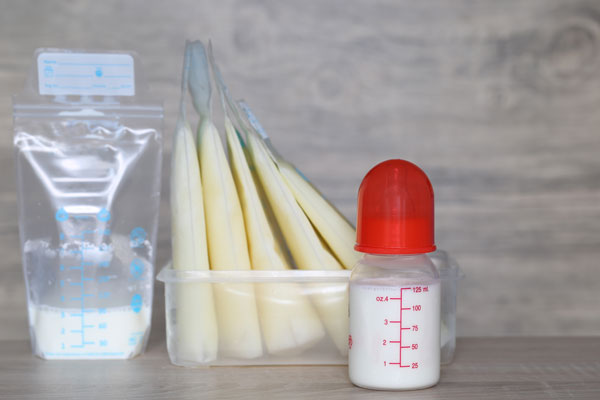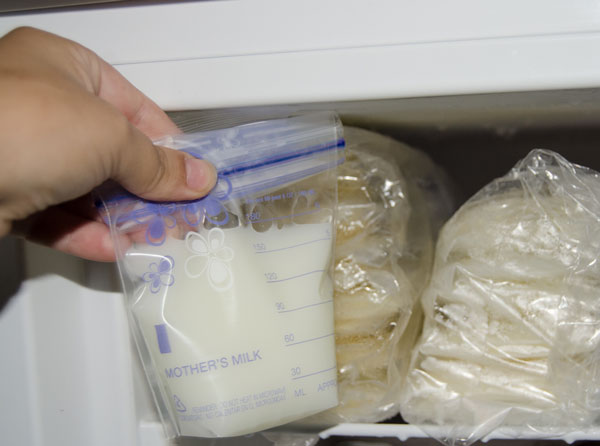How much breastmilk should I freeze? This is the question that every going-back-to-work mother wonders. In this article, you will find answers to all your stashing breastmilk questions. After discussing the reasons for storing breastmilk, when should you start pumping and storing, and how much breastmilk you should freeze will be addressed. Other tips and tricks related to breastmilk freezing and stashing will also be discussed.

Breastmilk is the best possible food for your little one. It keeps your baby healthy and boosts his immunity because of the presence of antibodies and anti-bacterial properties. Most of the mothers prefer to breastfeed their children exclusively. However, in certain situations, it is not possible to nurse your child. You can take care of your child’s hunger by providing him with expressed or pumped milk in such cases. Every mother who will freeze breastmilk for use in her absence to feed the baby has this question in mind. How much breast milk should I stockpile?
When do you need to freeze breastmilk?
But before calculating the amount of breastmilk to be freeze, first, you should be clear about the situations and settings in which it is required. Various circumstances that can warrant the storage of breastmilk are mentioned below.
- You are a working mom, now your maternity leave will end, and you have to get back to work.
- Your baby will be in the daycare and is not on formula milk and is exclusively breastfed.
- You are going on a work tour, or you have a date night planned.
- In some critical scenarios, the newborn is in NICU, and you have to feed your baby via bottle.
These are just a few situations to mentioned. So, before freezing the breastmilk, you should keep in mind that for which purpose you are going to use freeze breastmilk. Typically mothers build a breastmilk stash before ending the maternity leave and going to work.
When should I start pumping and saving breastmilk?
Most mothers usually have this question: when is it appropriate to start pumping and saving breastmilk for later use. However, the best time to begin the pump is variable for every mother. Breastfeeding can be difficult for some mothers, and they usually take some time to get used to this process. There can be other issues, including low milk supply, latching, or health issues. In such situations, don’t stress too much about pumping, as it can affect your breastmilk supply. If breastfeeding is going smoothly for you, you can start pumping and freezing breastmilk three weeks before joining your job.
It is essential and necessary to introduce a bottle to your baby when he is three to four weeks old to recognize and develop the habit of eating from a bottle.
How much breastmilk should I stockpile?

The amount of milk you should freeze depends on your job timing and the amount of milk your baby drinks during that time. It requires just a little calculation.
If your job timing is from 9 to 5 and adding two hours for commuting and other workplace problems.
- Your absence can be from 8 am to 6 pm.
- Note down how many times your baby nurse or feed during this period.
- Suppose it is 10 am, 12 pm, 2 pm, 4 pm, and 6 pm. And baby drinks 3 to 4 ounces.
- Thus five feedings and 3 to 4 ounce each time makes it 15 to 20 ounce per day.
- It is best to save milk for a maximum of a week because you will be pumping milk at your workplace, and this means you need to stash 105 to 140 ounces.
- You can collect the required amount by having three pumping sessions daily for 5 days and have 12-ounce milk daily.
Don’t stock too much as you will be using milk from the previous day on the weekdays and be available to feed your baby on weekends.
Some women began the process of stashing too early and end up having a lot of freeze breastmilk. Pumping too much can lead to blocked ducts and mastitis. However, your baby needs the milk from the stash on the first day of your work. Then he will be eating your pumped milk from the previous day. Suppose you are joining on Monday; your baby will take his food from your stash. At the same time, you will be pumping in your workplace. On Tuesday, your baby will be drinking the milk you pumped on Monday while you will be pumping again for your office’s Wednesday food.
Stashed milk will be used in emergencies.
In such a scenario where you are continuously refilling your stockpile, the frozen milk will be used in situations like when you forget pumped milk in the office refrigerator. If your baby didn’t finish the bottle, it was wasted but needed to feed again after a few hours, or the caretaker babysitter accidentally spilled the milk. In such scenarios, the stashed milk is of great relief for you.
For how long the frozen breastmilk can be used?
After asking how much breastmilk should I stockpile, another dilemma is how long I can use the frozen milk? The freeze breastmilk can be used for up to 12 months if stored properly in a freezer or deep freezer. However, if the hygienic procedure was not adopted during pumping and keeping or the freezer’s temperature fluctuates too much because of the frequent door opening or power outage, the milk can spoil. It is always best to use the latest milk. If you freeze milk a month back when your baby was seven months, it has antibodies that your baby needed at that age of 7 months. Thus it is advisable to use milk as soon as possible.
How to replenish your stash?
You can continue to pump in the early mornings or midnight when there is sufficient milk supply on weekdays. If this is too stressful for you, you can do pumping and storing on weekends when you will be home. You have to gain the advantage of these windows if you don’t want to finish your stock. Otherwise, you will be panicking and anxious in emergencies like sudden and urgent meetings at the office.
What if my milk supply is low?
If your milk supply is declining, it is normal. As the baby grew and began to shift to solid food, the food supply began to decrease. In such cases, you can massage your breasts before pumping, eat a diet and supplements that increase the milk flow, and consult your doctor or lactation expert if causing too much problem.
How to store breastmilk?
- It is advisable to freeze your milk in small quantities of 2 or 3 ounces. You can always defrost more if needed, but once the breastmilk is thawed, it cannot freeze again.
- Store the milk in breastmilk storage bags and freeze in a flattened form so that you maximally utilize your freezer space.
- Always label your storage bag with your baby’s date and name if you send the milk to daycare.
- Use the last stash first and store the latest breastmilk at the end of your stockpile. This way, your previous breastmilk will not go spoil because it was at the back of the pile.
I know it is easy to say than to do. Every mother doesn’t get an ideal situation to make things work correctly. You may not find enough time to pump at your office, or you may get busy on the weekend and couldn’t replenish your stock. Just remember there is no need to feel guilty and let yourself down. Things will work out; eventually, you have to keep an open mind and avail yourself whatever opportunity you get to pump and replenish your stash.
Some scientific facts for freezing breastmilk
Although, you find several research papers preferring freeze breastmilk over formula milk. However, the latest research studies have demonstrated that fats, proteins, and energy in breastmilk are depleted when stored for more than two weeks and are best to use within 72 hours. Regardless of the method of storing and thawing, the macronutrients in the milk have changed when freeze. (Gracia-Lara et al., 2012; Kim et al., 2019). But breastmilk is far superior to formula milk even if it is freeze and stored.




